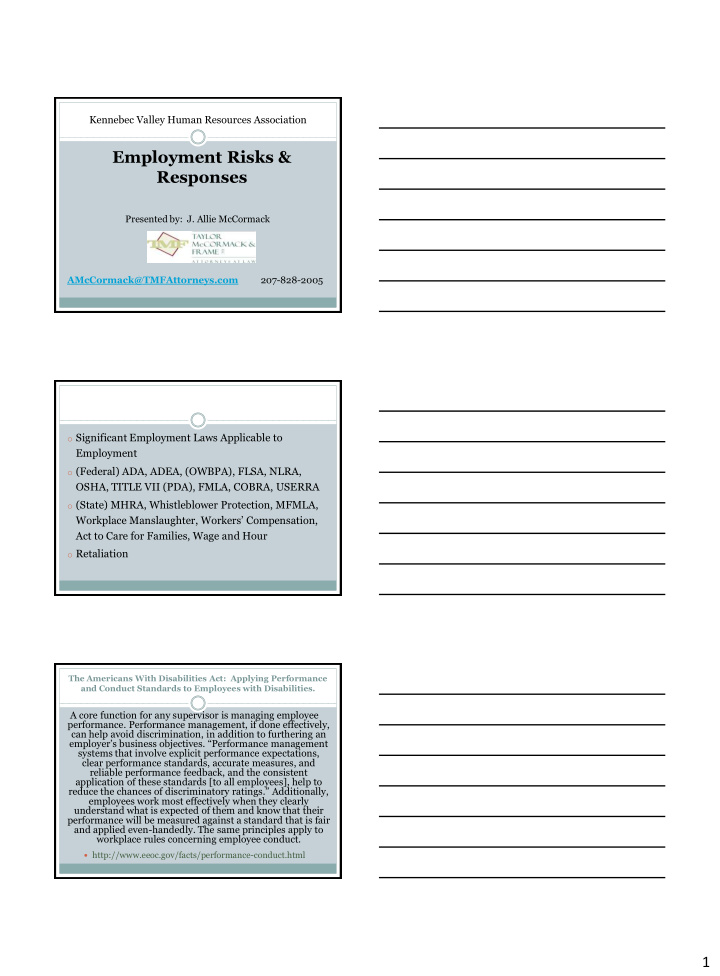



Kennebec Valley Human Resources Association Employment Risks & Responses Presented by: J. Allie McCormack AMcCormack@TMFAttorneys.com 207-828-2005 o Significant Employment Laws Applicable to Employment o (Federal) ADA, ADEA, (OWBPA), FLSA, NLRA, OSHA, TITLE VII (PDA), FMLA, COBRA, USERRA o (State) MHRA, Whistleblower Protection, MFMLA, Workplace Manslaughter, Workers’ Compensation, Act to Care for Families, Wage and Hour o Retaliation The Americans With Disabilities Act: Applying Performance and Conduct Standards to Employees with Disabilities. A core function for any supervisor is managing employee performance. Performance management, if done effectively, can help avoid discrimination, in addition to furthering an employer’s business objectives. “Performance management systems that involve explicit performance expectations, clear performance standards, accurate measures, and reliable performance feedback, and the consistent application of these standards [to all employees], help to reduce the chances of discriminatory ratings.” Additionally, employees work most effectively when they clearly understand what is expected of them and know that their performance will be measured against a standard that is fair and applied even-handedly. The same principles apply to workplace rules concerning employee conduct. http://www.eeoc.gov/facts/performance-conduct.html 1
Risk Reducing Suggestions - Comprehensive Application - Job Description (accurate & updated) - Background check - Orientation - Introductory Period (Probation) - Appropriate Employee Handbook Risk Increasing Strategies - No job description/inadequate job description - No/insufficient documentation - Failing to timely address performance issues - Taking too long to terminate poor performer - Failing to link termination decision to job description/Employee Handbook expectation Form of Documentation Application Work Place Posters Personnel policy/employee handbook Job description Orientation documents Memos to file (written record of oral warning) Should always be shared with employees/copied to employees Written warnings Evaluations Should reflect “memos” to file re oral warnings Emails Supervisor “notes ” 2
Social Media and the NLRB § 7 Protects rights of employees to “engage in other concerted activities for the purpose of collective bargaining or other mutual aid or protection ” Social networking = Water Cooler At will employment policies in hand book Mandatory arbitration agreements precluding class action claims Banner Health: Employer investigations 3
Purple communications: EE use of employer email systems on non work time presumptively ok Browning – Ferriss Industries of California Treating 2 or more separate entities as “joint employers” NLRB Poster App 4
MOU with OSHA 5/22/14 re §11(c) and ULP charge Application and Interpretation of MHRA/ADA/Workers’ Compensation/FMLA/MFMLA Workers’ Compensation Act Provides wage and medical benefits to employees who sustain work related injuries – at work and because of work. Employee must provide notice within 30 days of injury/illness Unless employer has actual knowledge of injury/illness Employees also have reinstatement rights and can’t be discriminated against for “asserting a claim”. 5
American’s with Disabilities Act / Maine Human Rights Act Employer must provide “reasonable accommodation” to a qualified individual with a disability. Unless above is an “undue hardship” or employee poses a “direct threat” to employee’s own safety or the safety of others. Qualified person with a disability means – person is able to do the essential functions of the job with or without reasonable accommodations. Interactive process Disability Federal definition ADA Amendments Act of 2008, effective 01/01/2009 Broadens definition of disability under Federal Law overturning USSC cases Disability assessment made without regard to mitigating measures (except “ordinary eyeglasses/contact lenses”) Maine definition - expansive Disability Further Defined Physical or mental impairment that substantially limits one or more major life activities Record of such an impairment Regarded as having such an impairment Whether or not impairment limits or perceived to limit a major life activity 6
Qualified Individual with a Disability Satisfies the requisite skill, experience, education, and other job-related requirements of the position; and Can perform the essential functions of the position with or without a reasonable accommodation. Federal Family Medical Leave Act A. Eligible Employee 1. Employed for 12 months (doesn’t have to be consecutive), 2. Worked 1250 hours. B. Entitled to 12 weeks of job protected, unpaid leave for: 1. Birth, 2. Employee’s serious health condition, and/or 3. Serious health condition of Employee’s spouse, parent or child. C. Continuation of Employer cost of health benefits. D. 50 or more Employees within 75 mile radius Maine Family Medical Leave Act 12 consecutive months employed, No hour requirements, 10 weeks unpaid leave during 2 year period, and Applies to domestic partners and donation of organs in addition to Federal FMLA leave entitlement. May make arrangement with employee to continue benefits at employee’s expense. 15 or more employees. 7
Summary Workers’ Compensation Act - Imposes reasonable accommodation obligation on employer to allow employee to work and reinstatement rights to available open positions the employee is qualified to perform. ADA/MHRA - Imposes reasonable accommodation obligation on employer to allow employee to work, including reassignment rights to available open positions the employee is qualified to perform. FMLA - Provides employee with right not to work. “Light” Duty/Transitional Duty Conflict Employee has obligation to accept a “ bona fide offer of reasonable employment . . . .” Title 39 -A M.R.S. §214(1). If unreasonable refusal, employee no longer entitled to wage loss benefits under the Act during the period of the refusal. Under FMLA (federal), “light duty” must be “voluntary” and “uncoerced.” 29 C.F.R. §825.220(d). “If FMLA entitles an employee to leave, an employer may not, in lieu of FMLA leave entitlement, require an employee to take a job with a reasonable accommodation.” 29 C.F.R. §825.702(d)(1). 8
A “worker’s compensation absence and FMLA leave may run concurrently . . . . At some point the health care provider providing medical care pursuant to the worker’s compensation injury may certify the employee is able to return to work in a light duty position. If the employer offers such a position, the employee is permitted but not required to accept the position .” 29 C.F.R. §825.702(d)(2). (emphasis added) 9
Recommend
More recommend